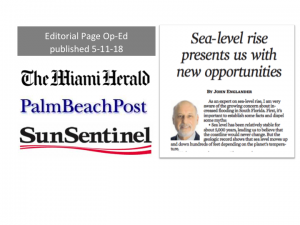Sea-level rise presents new opportunities for South Florida
- Sea level has been relatively stable for about 5,000 years, leading us to believe that the coastline would never change. But the geologic record shows that sea level moves up and down hundreds of feet depending on the planet’s temperature.
- We have entered a new era. The oceans have gotten so warm that ice sheets and glaciers will continue to melt and the sea will continue to rise for centuries. We have passed a tipping point where sea level rise can no longer be stopped.
- Melting icebergs and the polar icecap do not add to sea level as they are floating ice. Higher sea level will mostly come from melting ice sheets and glaciers on land, 98 percent of which are in Antarctica and Greenland.
- To slow sea-level rise, we must dramatically reduce emissions of greenhouse gases — particularly carbon dioxide — that trap heat in the atmosphere. Oceans absorb that heat. Warm water expands. It also melts a lot of the planet’s ice. We need to work vigorously to slow the warming.
- Rising sea level makes flooding from storms, extreme “king tides” and rainfall worse.
- The Southeast Florida Regional Climate Change Compact’s latest projections are that sea level in our region could rise 2 to 3 feet by 2060 and 5 to7 feet by the end-of-century.
Although South Florida is often thought of as being particularly exposed, we are not alone. Tampa Bay, Jacksonville, and the Panhandle are highly vulnerable, too. Looking farther, from Annapolis to San Francisco and from Boston to Bangladesh, flooding is breaking records. In fact, about 10,000 coastal communities are now exposed to increased flooding.
We are in a new era, quite unlike recent centuries. We have to start our adaptation now. The rewards will go to those people, companies, and communities that plan for the future.
What can we do?
- Assess flood vulnerability. Short-term flood events and the gradually rising sea level are going to be permanent challenges. This applies to homeowners, businesses, investors, and communities.
- Evaluate ways to reduce flood exposure, such as raising the grade, elevating structures, and installing pumps.
- Beyond your own property boundary, look at how flooding will affect roads, utilities, and infrastructure near you.
- Find out what your community is doing to be more resilient. What are government plans to cope with short-term flooding and long-term rising sea level. Put pressure on your local government representatives to put these issues on their agenda.
- Based on all the above, as well as your stage in life, decide if and when it is time to relocate.
- While there will be losers from rising sea level, there will also be winners. Look for opportunities to encourage the shift, taking advantage of good economic incentives where appropriate.
- Educate others: friends, family, associates, and your community about this important topic.
Rising sea level presents an unprecedented threat to all coastal communities, but also presents a tremendous opportunity. People will always want to live by the coasts and need coastal access for ports and recreation. There will be future coastal cities.
Those communities that boldly prepare will establish global reputations. That will not only put a floor under property values, it can position them to be part of a huge growth business. Adapting to higher sea level will almost certainly be one of the most powerful economic engines of this century.
I recommend that communities should begin planning for the first 3 feet of sea-level rise as soon as possible, and more where feasible. On our current path, 3 feet could happen by 2060. Now is the time to begin adapting to today’s rising water and design futuristic communities for people who want to live next to the water in the decades to come.
We have decades to adapt, but we have no time to waste.
John Englander is an oceanographer and author of “High Tide On Main Street.” He is also president of The International Sea Level Institute, a new nonprofit think tank and policy center. His weekly blog and news digest can be found at www.sealevelrisenow.com
Of course the challenge to adapt cannot be overstated. It will be one of the defining issues this century for the entire planet.
I believe we need to approach it with realism, look at it in proper scale, and see the immense opportunity along with the power of destruction and transformation.
It may be the ultimate situation of looking at something as “a glass half empty or half full.”

